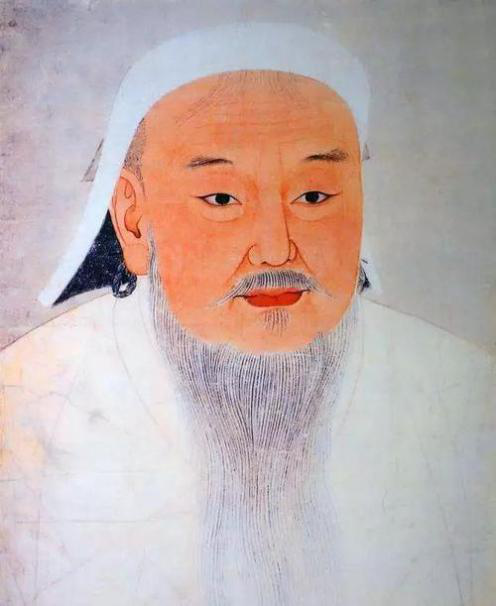
Genghis Khan, one of the greatest conquerors of the world’s history, who unified the feuding tribes of Mongolia and forged them into a mighty nation. Yet his ambition did not lessen, the iron heel of Genghis Khan trampled on the Eurasian continent and China. The territory at his peak period starts from the Korean Peninsula in the East, reaches Poland and Hungary in the west; from Russia's principalities in Siberia in the north, and reaches the Central South Peninsula of Java. Even after his death, his name remains fearsome among his realm.
For those nations who vanquished by Genghis Khan, he might be a symbol of terror. But this was only one side of this legendary figure. Who can imagine, the unstoppable conqueror was once only a poor boy who struggling for survival. The path of his rise was filled with bitterness and agony.
In 1162, nearing the upstream of Onon River, Khentii Mountains of Khamag Mongol, a baby was born with a blood clot in his tiny fist. According to the tribal tradition, this was an omen that portended the kid was fated to accomplish great cause. On the same day, the boy was born, his father, Yesukhei, the leader of Kiyad tribe and a noble warrior of the Borjigin clan, captured the chief of a rival Tartar tribe, Temüjin-üge. To honor this victory, he named his newborn son after his trophy—Temüjin-Borjigin.
Everything was fine until Yesukhei died. At the year that Temüjin turned nine, Yesukhei took him to another tribe to seek a marriage alliance. There, young Temüjin met her future wife, Börte. The father and son achieved their goal and returned home happily. On their way back, they met a group of Tartar warriors who were having a dining party. The forthright Yesukhei was in a very good mood, he decided to join their party, disregarded the resentment between the Kiyad and Tarar. However, the Tartars did not forget how they were shamefully defeated by Yesukhei. So they secretly offered Yesukhei poisoned food.
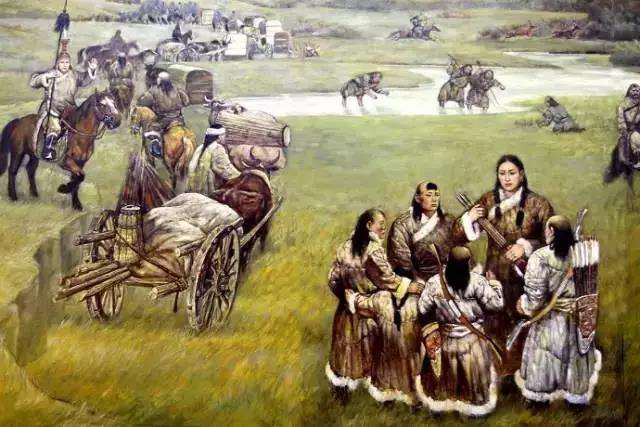
Yesukhei died, leaving two widows and seven children under ten. Temüjin’s birth mother, Hoelun, the second wife of Yesukhei, was suppose to remarry to another man from her tribe, yet no man was willing to accept her family. The rules on the grassland can be cruel. As there was no grown man in her family, they don’t have the right to share the food. After the chief’s death, the Tayichi’ud clan controls the tribe. While the tribe moved to the next pasture, they abandoned Temüjin’s family.
Without the protection of the tribe, young Temüjin and his family had to fight for their living. Luckily, Temüjin got a great mother. This strong woman took over the heavy burden. She picked wild fruits and vegetables every day to support the kids, taught the children how to sharpen the animal bones as weapons, made wooden arrows, and hunt small animals like rats.
This family did not perish under the cruel “law of the grassland”. Instead, they survived and built up incredible strong will and endurance.
Though Temüjin had been through a lot with his half-brothers, their brotherhood was not strengthened by it. The younger half-brother, Bekhter repeatedly snatched the animals hunted by Temüjin and even stole the food stocks of the whole family, which threatened their survival. The consequences of Bekhter’s irresponsible and arrogant behavior was fatal.
One day, he robbed a saltwater fish from Temüjin, later that day, he seized a lark from his brother. Temüjin’s patience wore out, the authority of the eldest son will not be challenged again. He brought his brother, Qasar, and shot Bekhter front and back. Before Bekhter’s death, Temüjin granted his last wish: to let his brother Belgutei live. Belgutei pledged his loyalty to Temüjin after this tragedy. Both Qasar and Belgutei had become a reliable and powerful ally on Temüjin’s future conquest.
As Temüjin grows older, Taliqu, the chief of the Tayichi’ ud fear that one day he may seek revenge for banishing Temüjin’s family from the tribe, so he sent troops to capture Temüjin. Luckily, with the help of a kind family of Tayichi’ ud, Temüjin escaped successfully.
After all those tough experiences Temüjin has been suffered, he deeply realized that without the protection of a strong ally, he can’t protect his family. While he sought an alliance, he met his “anda (best friend, blood brother)” Jamukha, an aristocrat from the Jadaran tribe, neighboring the Kiyad tribe. These two young men became very close soon after they first met. They hunt and ride together, practice archery, and fighting skills. They traded token of brotherhood and even swore to be each others’ blood brother twice. A year later, they exchanged arrow with each other, which was a sacred symbol of allying with warriors.

At the age of 16, Temüjin fulfilled the engagement and married Börte. According to the tribal tradition, Temüjin must offer a gift to his father. Since his father died, Temüjin decided to offer a nice sable fur to Yesukhei’s anda, Toghrul, the Khan of the Keraites tribe, and pledged his loyalty to Toghrul. Toghrul learned the tragic story of Temüjin, he accepted Temüjin’s gift and took him as a foster son.
The Keraites lived in the most fertile grassland in the central part of the Mongolian Plateau. When Toghrul was young, Yesukhei fought with him to overthrow the former leader of the Keraites and helped him became the new chief. In 1197, Toghrul was granted the title of “Wang Khan” by the Jin Dynasty.
With the support of the Keraites, Temüjin got his territory. The former followers of Yesukhei heard the news and turned to him. He was becoming a leader. Temüjin finally settled down and had quite a great time with his family at their campsite. Yet good times never last, especially with the chaotic situation on the turbulent grassland. The pillage between tribes can happen all the time.
The peaceful life of Temüjin was broken by an unexpected raid. The Merkit tribe attacked Temüjin’s campsite, seized his newlywed wife Börte and some other female members. Temüjin was unprepared for the battle, though he got some followers, still, they were outnumbered. He fled, because he knew fighting a losing battle is meaningless, a dead man can not rescue Börte.
The wife was taken, people were slaughtered, Temüjin would suffer humiliation for the rest of his life if he doesn’t have his revenge. So he went to his adoptive father Wang Khan and his anda Jamukha for help. They assembled an army with over 40,000 warriors lead by Jamukha.
Temüjin’s first military action crushed the Merkits. Not only rescued Börte and other hostages successfully, but the coalition army also plundered a large number of property and slaves. More importantly, Temüjin’s prestige was greatly improved, more people chose to join him voluntarily. At that time, Temüjin only wanted a peaceful life back. He took his clansmen to join Jamukha, together they celebrate the great union. Temüjin and Jamukha had never been closer then. But who knows, in later years, the sworn brothers had become each others’ sworn enemy.
This war probably took place between 1180 and 1184, and it is considered as an important turning point of Temüjin. The great Genghis Khan rises from now.
In 1189, Temüjin had earned his reputation after the first battle, several nobles of the Kiyad tribe broke away from the control of Tayichi’ ud, and turned to Temüjin, formed the new Kiyad noble union, and elected Temüjin as their Khan. With the power, Temüjin grows stronger. Jamukha, the Khan of Jadaran began to fear that his anda might threaten his position. Since then, disagreement and doubts slowly consumed their brotherhood. Temüjin also didn’t want to live under Jamukha’s roof forever. Finally, their tribe separated, Temüjin chose to leave and start his own rule.
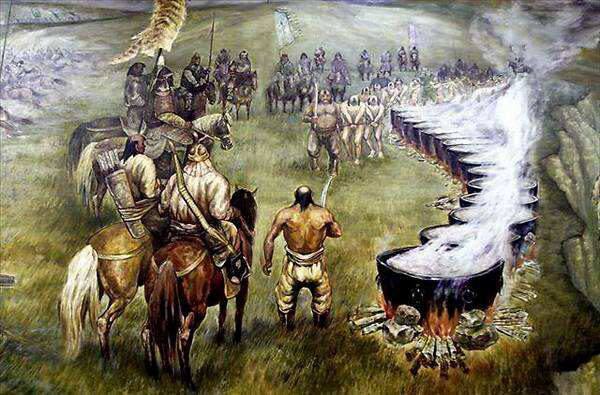
The second year, one of Jamukha’s clansman was killed while he was raiding livestock from Temüjin’s tribe. Jamukha got this rightful excuse and claimed to revenge for his clansman. He assembled a 30,000 men army with the Tayichi’ ud tribe and declared war on Temüjin. To defend against the attack, Temüjin divided his army into thirteen forces. This battle was known as the “Battle of the Thirteen Kings”.
This battle was a fiasco to Temüjin, he was up against one of the best strategist of Mongol. His troops were torn by the union army under the command of Jamukha, countless warriors were taken and prisoned. Furious Jamukha commenced a brutal retaliation on Temüjin’s men. He beheaded one of the rival general, and tied his head on the horsetail, dragged it until it’s mutilated. He also set seventy cauldrons with hot waters and boiled those prisoners alive.
Unlike the ruthless Jamukha and savage Tayichi’ ud tribe, Temüjin tried his best to win over the hearts of the people by treating them generously. The horrifying atrocity of Jamukha irritated some of his people, and the cruel actions of Tayichi’ ud nobles intensified the contradiction between them and their followers. In these cases, many of them broke away from Jadaran and Tayichi’ ud and turned to Temüjin.
Temüjin lost a battle, yet he won the people’s favor, which was a crucial part for the future unification.
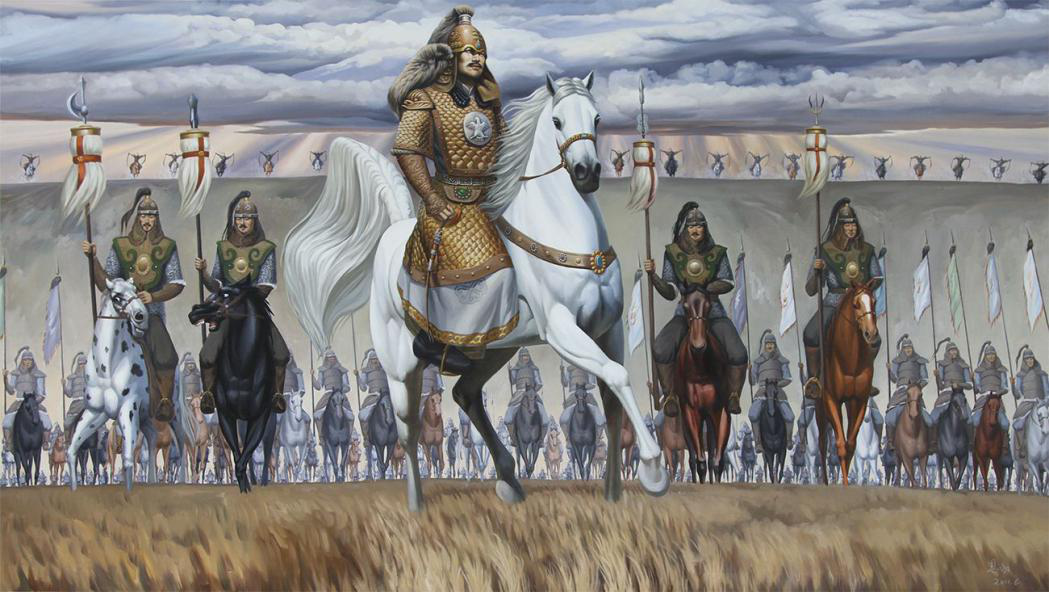
In 1196, the Tartar tribe rebel against the Jin Dynasty yet suppressed by Jin. Temüjin informed Wang Khan, they lead an army in the name of revenge for Yesukhei and gathered the remaining Tartar troops. Finally, he captured the Tartar chief, delivered him to Jin, and fulfilled his revenge. He and Wang Khan were also rewarded by Jin for this action. It greatly improved the prestige and power of Temüjin. From then on, he could command the aristocrats of the various families in the status of the chief of the tribe appointed by the Jin Dynasty.
After returning to the Kiyad tribe, Temüjin accused Djurki’s leader of refusing to revenge for his father and attacked Temüjin’s campsite while he was out fighting. So he could eliminate a strong noble branch tribe of Kiyad, Djurki, who threatened his leading position. In 1200, Temüjin and Wang Khan assaulted Tayichi’ ud tribe and killed their chief. Unlike the traditional ways, Temüjin did not dismiss or slaughter enemy troops or civilians, instead, he incorporated the soldiers into his army, and accepted the civilians joining his tribe. This merciful reaction made Temüjin stronger after each battle against the loose tribes. Gradually, Temüjin occupied the eastern part of the Mongolian Plateau.
The nobles of the remaining tribes dreaded the rise of Temüjin, and they formed a twelve-tribe alliance and elected Jamukha as “Gurkhan(Khan of all Khans)”, swore to destroy Temüjin. Yet Temüjin was no longer the unseasoned leader, his union army with the Keraites defeated the twelve-tribe alliance within a day. After the victory, Temüjin thought of the former friendship with Jamukha and delivered him to Wang Khan’s camp, spared his life.
Temüjin’s rapid growth brought caused caused the resentment of Senggum, son of Wang Khan. So he secretly sabotaged the relationship between his father and Temüjin, which planted the seeds of conflict.
In 1202, Temüjin proposed to tighten their alliance by marrying Wang Khan’s granddaughter to Temüjin’s first son. The arrogant Senggum opposed this marriage. This disrespectful and insulting action eventually caused a war.
Wang Khan allied with Jamukha outnumbered Temüjin. After years, Temüjin tasted the bitterness of failure again. He swore to have his revenge.
He was a man of his words. At the fall of the next year, he reassembled an army and raided the base camp of Keraites eliminated the whole tribe. Wang Khan Toghrul fled to the border of Naiman, and he was mistaken for a spy by the sentries and died because of it.
After the extinction of the Keraites tribe, the Naiman tribe was the only force in the Mongols who stood a chance to fight Temüjin’s army. Jamukha went to Tayang Khan, the chief of Namian for shelter. In 1204, Temüjin marched south and eliminated the Namian, finished the last puzzle of his unification.
Jamukha fled with only five men left with him. These five men betrayed Jamukha and delivered him to Temüjin for a reward. They did not know the reward was their execution.
Allegedly, Temüjin intended to spare Jamukha again. He even offered Jamukha to rejoin him. Jamukha refused his offer. Before his death, he told Temüjin, “If I live, you will never sleep soundly again, I will always be the louse in your collar, the sting in your robe. My anda, from the land of sunrise to the land of sunset, no one doesn't understand our brotherhood.” Temüjin granted his last wish, a noble death with no blood spilled.

Three years after the fall of the Kali tribe, there were no more loose tribes in the grassland, such as the Merkiti, the Jadaran, or Tatar. These tribes had already submitted themselves to the same man and became a unified nation – Mongolia. In 1206, Temüjin held Khuruldai (a council meeting of tribes and alliance of various ministries) at the upper stream of the Onon river, where he was elected to be the Khan of all the tribal union and officially use the title of “Genghis Khan (mighty as the ocean)”. It was only the beginning of his conquest.
After the establishment of the Mongol empire, Genghis Khan began to launch a large-scale war of conquest to the external world, with the footprints from the Jin Dynasty and Western Xia in East Asia to the coast of the Black Sea in Central Asia and Eastern Europe.
Since 1205, Genghis Khan attacked Western Xia three times, defeated the main force, and compelled them to assist him to conquer the Jin Dynasty.
In 1211, Genghis Khan led the army himself to attack Jin, annihilated their elite troops with changeful strategies. During the next six years, Genghis Khan wiped out multiple strongholds of Jin and took over eight major cities including the capital of Jin.
In 1217, Genghis Khan delegated Muqali as chief commander of the attack on Jin, while he brought the main force back to Mongol and prepared to march west.
In 1218, Genghis Khan sent the vanguard general Jebe to destroy the power of Qara Khitai, also known as Western Liao, and clear the obstacles of the western expedition.
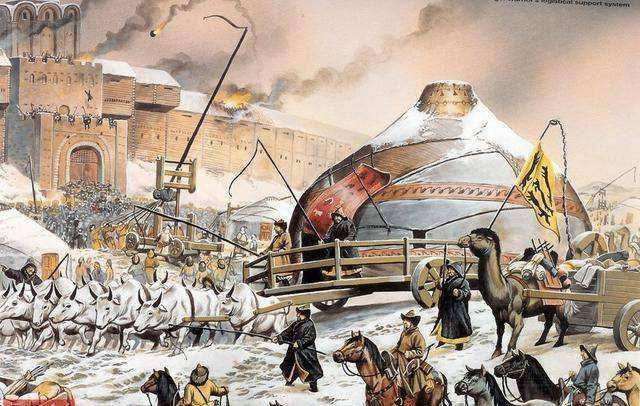
In 1219, Inalchuq of Otrar city believed the Mongol spies were mingled in the 499 merchants of Mongol, so he ordered to execute them all. Genghis Khan sent three ambassadors to meet Shah Ala ad-Din Muhammad, the king of Khwarezmia. Yet the arrogant king beheaded one of the ambassadors and ask the remaining two to bring the head back to their lord. Genghis Khan went furious, and he organized one of his largest military campaigns with over 100,000 warriors, swept the Khwarezmia, and sent Jebe, Subut to pursue the fled Shah Ala ad-Din.
After the destruction of Khwarezmia, the cavalry of Urgench and the princes of Rus was also defeated, and the ancient Indus and Volga rivers became the battlefields of fierce competition. Jalalad-Din-Minghurnu, the prince of Khwarezmia, led the remnant troops to resist and destroyed nearly 30000 Mongolian soldiers in the battle of Balu. However, Khwarezmia’s fate was doomed, and Jalalad was besieged by the Shenhe river. Finally, he broke through and fled to India.
In 1226, Genghis Khan chose to return to Mongol, ended the seven years of western conquest. Because Western Xia betrayed the alliance, the commander chief Muqali died because of heavily wound with hatred. Genghis Khan, regardless of his sixty-four years old, insisted on his expedition to Western Xia. He was injured in hunting on the way, though he suffered from having a high fever, still, he didn't retreat. At the end of the Western Xia Dynasty, Emperor Li Jun was forced to send envoys to seek peace.
After Genghis Khan was critically ill, he recuperated in Liupan Mountain and left his wills, “Took advantage of the feuds of the Song and Jin Dynasties to pass through the territory of Song, and united them to destroy the Jin Dynasty.” In 1234, his third son Ögedei and Tolui fulfilled his will, destroyed the Jin Dynasty.
In 1227, Genghis Khan died. His children honored his wish, buried him at an unmarked grave, and no one found it until today.
1. Unified Mongolia, built up the Mongol empire, ended the centuries of chaotic feuding situation of Mongolia.
2. Established the “Thousand Household System" of military and political integration, appointed several thousand household officials and royal families, and established a military and political organization with a flexible command, easy to rule, and good at fighting.
3. Had people creating Mongolian characters, so he can promulgate statute law and record the history.
In the next few centuries, the descends of Genghis Khan almost doubled his original territory. They ruled the Eurasian Empire, large and small, with different titles. From Russia, Turkey, India to China, including emperors, Khans, sultans, kings, emirs (Archduke), the roots of the golden families entrenched the world.
Genghis Khan became the code word of destruction and conquest, and also a complex cultural symbol. Take a look at this world-known conqueror, for the first half of his life, he was just a normal tribesman who struggled to survive.
